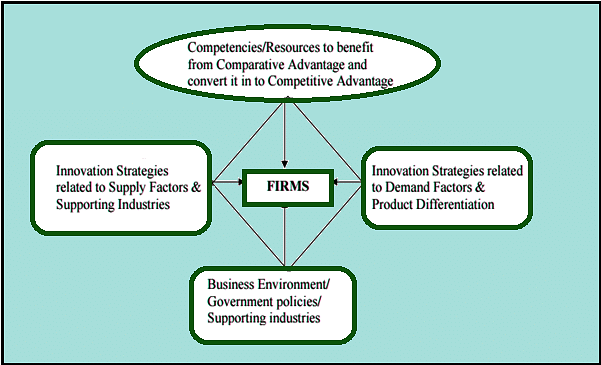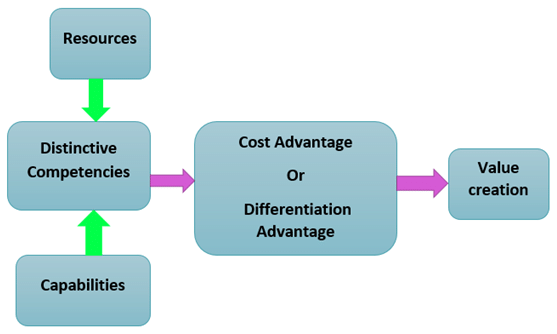Competitive Advantage of a Firm | Management Optional Notes for UPSC PDF Download
Introduction
Competitive advantage holds significant relevance across various domains. It signifies the edge achieved over rivals by delivering superior value to customers, achieved through either lower prices or by offering additional benefits and services that rationalize comparable or potentially higher prices. For manufacturers engaged in niche marketing, identifying and cultivating a competitive advantage can result in heightened profits and the establishment of a sustainable and prosperous venture in the long run. As per management literature, a company is deemed to possess a competitive advantage when it successfully implements a value-creating strategy not concurrently adopted by any existing or potential competitors (Barney, 1991: 102).
Competitive advantage means having an edge over other businesses in the same industry. It's a theory that aims to address some of the criticisms of the concept of comparative advantage.
How to Get Competitive Advantage:
- Companies gain a competitive advantage when they are more productive and profitable than their competitors.
- Peteraf defines competitive advantage as "sustained above normal returns" (1993).
- Specialized resources unique to a company can contribute to its competitive advantage because the benefits they offer are not easily replicated by competitors.
Ways to Achieve Competitive Advantage:
- Offering lower prices.
- Providing clearly superior products at slightly higher prices.
- Delivering products faster.
- Offering excellent customer service, including after-sales support.
Factors Contributing to Competitive Advantage:
- Exceptionality, value, incapability to be imitated, and inability to be substituted (Barney, 1991).
- Important potential resources such as financial, physical, legal, human, organizational, informational, and rational (Hunt and Morgan, 1995).
- Developing superior core competencies by combining skills and resources (Prahalad and Hamel, 1990).
- Dynamic capabilities of possessing, allocating, and upgrading distinctive resources.
Resource-Based Theory Approach:
- Focuses on the relationship between resources, capabilities, competitive advantage, and profitability.
- Four factors advantageous for firms to increase their depth: strategy, competitive advantage, capabilities, and resources (Grant 1991).
Basic Foundations for Development:
- Five forces include competitors, threat of new entrants, substitute products, bargaining power of suppliers, and bargaining power of buyers (Porter 1998).
- Companies protect themselves against competitive forces.
- Porter's framework of competitive advantage emphasizes competitive strategies like low cost and/or product differentiation.
Porter's Perspective:
- Competitive advantage is crucial for firms to remain in competition.
- It's directly related to competition, whether within departments or between firms worldwide.
- Managers need to understand the firm's current position and strive to differentiate it to target customers effectively (Porter 1998).
Determinants of competitive advantage
Competitive advantage refers to the unique strengths and capabilities that set a business apart from its competitors in the marketplace. These strengths and competencies enable the business to offer superior products or services, or to operate more efficiently, thereby gaining an edge over rivals.
Key Factors for Gaining Competitive Advantage
Efficiency:
- Efficiency is the ability to achieve maximum output with minimal input. This involves optimizing resources such as materials, labor, time, and capital.
- An efficient business can produce goods or deliver services at lower costs while maintaining quality, which gives it a competitive advantage.
- By reducing costs through efficiency, a business can offer competitive prices or higher margins, which attracts customers and enhances profitability.
Quality:
- Quality refers to the excellence or superiority of products and services provided by a business.
- Customers are naturally drawn to products and services that meet or exceed their expectations in terms of performance, reliability, durability, and other attributes.
- Offering high-quality products and services helps a business differentiate itself from competitors and build a loyal customer base, thereby gaining a competitive advantage in the market.
Innovation:
- Innovation involves the creation or improvement of products, services, processes, or business models to meet evolving customer needs and preferences.
- Businesses that innovate continuously can introduce new and unique offerings that stand out in the market and attract customers.
- Innovation allows businesses to stay ahead of competitors, adapt to changing market conditions, and capitalize on emerging opportunities, thus contributing to their competitive advantage.
Customer Responsiveness:
- Customer responsiveness involves understanding and addressing the needs, preferences, and concerns of customers in a timely and effective manner.
- Businesses that are responsive to customer feedback and market trends can tailor their products, services, and marketing strategies to better serve their target audience.
- By delivering superior customer experiences and value propositions, businesses can enhance customer satisfaction, loyalty, and retention, thereby gaining a competitive edge over rivals.
Model of competitive advantage

It can be concluded that a company attains a competitive advantage by doing something that its competitors cannot. Scholars in management emphasize that a competitive advantage is achieved through the implementation of strategies that create value.
FAQs on Competitive Advantage of a Firm - Management Optional Notes for UPSC
| 1. What is competitive advantage and why is it important for a firm? |  |
| 2. How can a firm gain a competitive advantage? |  |
| 3. What are the types of competitive advantage that a firm can have? |  |
| 4. How can a firm sustain its competitive advantage in the long term? |  |
| 5. Can a firm have multiple competitive advantages? |  |




















